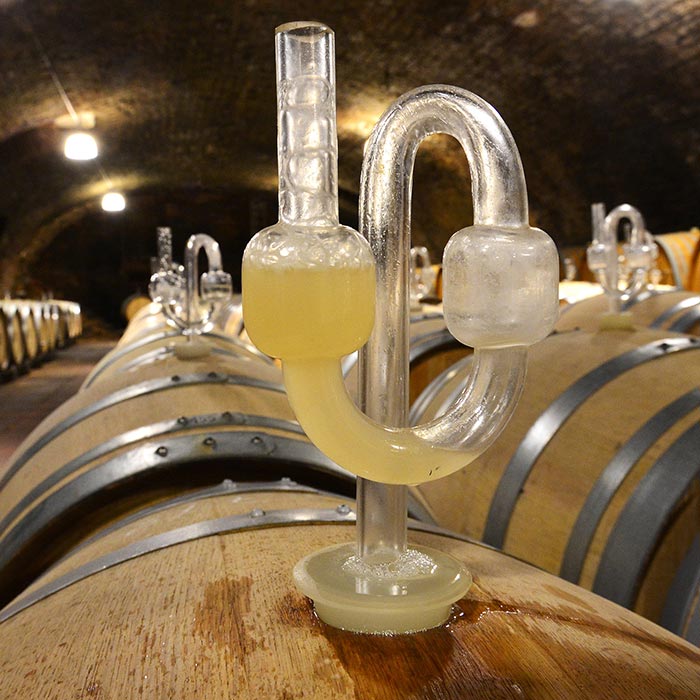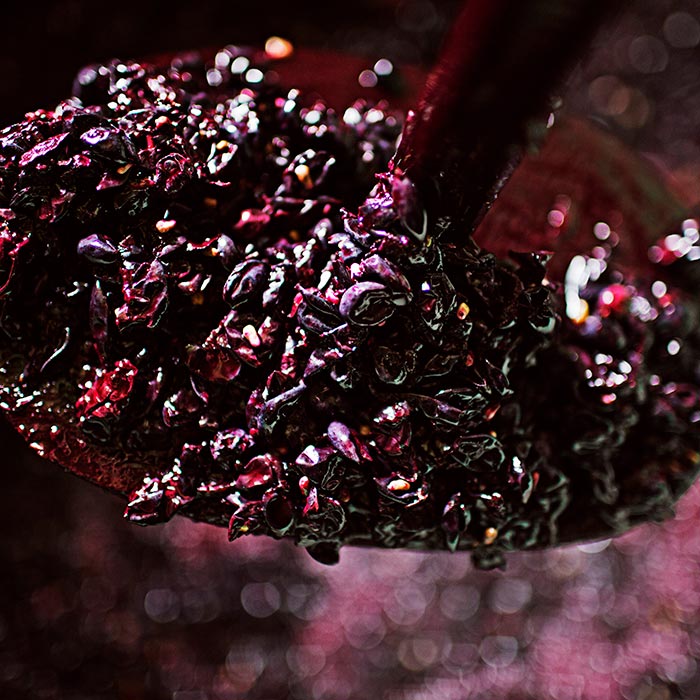Does spontaneous fermentation produce wines with more character? Tim Bernhard worked on studies on the biochemistry of wine at the universities of Geisenheim and Gießen. Today he runs the Paulinenhof winery in Rheinhessen. Bernhard explained to Kristine Bäder how spontaneous fermentation works.
What exactly does a yeast do in wine production?
Tim Bernhard: Yeasts are microorganisms and belong to the fungi. They are so small that they can only be seen under a microscope, their size is in the micrometre range. You can think of yeast strains as little craftsmen who make something. In the case of wine, they want to produce energy - and to do this they convert the sugar in the must into alcohol via several stations. Initially, they only exist in small numbers. But in order to process the sugar in the entire must, yeasts must reach a certain population size. Therefore, they first intensively divide their cells. This is called the start-up phase.
Which yeasts are important for wine fermentation?
Tim Bernhard: Among the yeasts, there are specialists that are particularly good at something: For example, they work under cool temperatures. Or at high acidity levels. So the yeasts in the must have different talents. The most important among them is the wine yeast: Saccharomyces cerevisiae. It is the only one that can produce alcohol contents above ten percent by volume. It is the "super craftsman" and is also used in brewing beer and baking bread.
What distinguishes pure yeast from "wild" yeast?
Tim Bernhard: All yeasts occur wild in nature. Pure yeast is also not artificial yeast, but of natural origin. However, it has been specifically selected and propagated - at least in Germany, where genetic engineering is prohibited. In America, there are also genetically modified yeasts that are, for example, capable of fermentation and biological acid degradation (BSA) at the same time. However, wild yeasts do not belong to the saccharomycetes, i.e. the wine yeasts. They can start alcoholic fermentation, but they cannot complete it. Wild yeasts sometimes produce interesting notes, but there are also many that do not produce such great aromas.

Whether "spontaneous" or with pure-breeding yeasts: fermentation should proceed quickly.
© German Wine InstituteThere are also yeasts that are supposed to express certain aromas.
Tim Bernhard: Some aromas in wine are bound to certain molecules. In order to develop them, they must first be split off. aromatic yeasts ensures that this splitting takes place faster as well as earlier. aromatic yeasts therefore does not make the wine more aromatic, but accelerates the ripening process. This is why wines produced with it do not have a long ageing potential.
Does fermentation with wild yeasts proceed differently than with pure-bred yeasts?
Tim Bernhard: In spontaneous fermentation, must enters the wine tank and encounters many different yeasts. They all want to colonise this must. So they all start to ferment the sugar. But in the end, the wine yeast Saccharomyces cerevisiae prevails and completes the fermentation. When fermenting with pure yeast, the must is inoculated with Saccharomyces cerevisiae, which have been selected and propagated from nature beforehand. It spreads quickly in the must and starts fermentation before the wild yeasts can even become active. Because they need much longer to multiply. This is the big difference between pure yeast and wild yeast: the winemaker knows what the pure yeast is doing, with wild yeasts there is always an uncertainty factor.
Under what circumstances does a must ferment without any problems without the addition of pure yeast?
Tim Bernhard: When my cellar is in order, when mould is not sprouting in every corner, when the nutrient supply in the must is very good and the temperature is right. And really only with optimally healthy grapes.
Can you taste the difference between fermentation with pure cultured yeast or natural yeast in the wine?
Tim Bernhard: Over the years, an individual cellar flora builds up in the cellar due to the composition of the yeasts present. This is a mixture of the yeasts that are already there, the pure yeasts used in the past and - very importantly - the yeasts that are added externally. They can all continue to develop and change. You can actually taste this cellar flora in the wine as an individual note.

Healthy grapes are important for successful fermentation.
© German Wine InstituteDoes this individual combination result in the famous Sponti note in the wine?
Tim Bernhard: The so-called spontaneous fermentation note, or "Sponti note" for short, occurs when the fermentation conditions are not optimal. The spontaneous fermentation takes longer, and this results in impurities and small blemishes. In principle, these are blemishes that shape the special character of a wine. In the meantime, however, there are also "wild" yeasts available for purchase that have been selected and propagated to bring precisely these notes into the wine. Wild pure-breeding yeasts, so to speak.
Where is the border between blemish and wine defect in spontaneous fermentation?
Tim Bernhard: There are yeasts that only produce faulty aromas. Or the wine yeast does not manage to assert itself during fermentation. This happens, for example, when the supply of nutrients is too low, the yeast strains do not multiply sufficiently, so there are not enough of them. As a result, fermentation stops at five to a maximum of nine percent alcohol by volume. This opens the doors to the bad yeasts and the bacteria.
It is often said: Only spontaneous fermentation brings out the wine's natural aromas. Is that true?
Tim Bernhard: The myth arises mainly because communication is so black and white and simplistic. This creates a false image. In a spontaneous fermentation, the yeasts do not necessarily differ from a fermentation with pure-bred yeasts. Spontaneous fermentation only means that the winemaker uses yeasts that are already present in the cellar flora. However, this is a "black box" in every vintage.
Note: Due to an oversight in the editorial department, the first version initially contained a headline that did not correspond to Tim Bernhard's intention and statement. We have corrected the error and apologise.